|
|
|||
|
(Back to Preceding Week; on to Next Week) |
|
BIG WEEK: We first met Ernesto Carman Jr. on 26 December 2004, when we got off an airplane at Liberia airport in Guanacaste Province, Costa Rica. A mere lad of 21, Ernesto was already one of the most accomplished field ornithologists in his Central American country, From the moment we deplaned on that first trip and were greeted by Ernesto we knew we had a winner. Far more than a top-notch naturalist and local guide, through the years Ernesto has become a close friend and colleague whose sharp eyes, keen ears, pleasant demeanor, and high-intensity work ethic have made him an indispensable partner in the field. When he's not collaborating on our hummingbird expeditions, Ernesto has two main jobs: 1) Helping his parents run Finca Cristina, an incredibly efficient fully organic, shade-grown coffee farm in Paraiso at which he is also establishing his own nature preserve; and, 2) Working as an expert bird guide for individuals and groups. Upon picking up Ernesto this week at the Charlotte NC airport, we came straight back to York SC. Our guest--who has heard so much about Hilton Pond Center--was eager to explore the property, so as soon as we unloaded his luggage we grabbed binoculars and hit the trails. The young Costa Rican was enthralled with our tales of how the Center during the past 26 years--his lifetime!--had changed from a working farm to a young Piedmont forest.
As we navigated the trails Ernesto took note of all sorts of plants and animals new to him, and we worked hard to identify each and talk about its ecological significance in the Carolina Piedmont. On one of our walks around Hilton Pond Ernesto spied at waist level a interesting insect perched in a small shrub. Its abdomen stuck straight up (see photo below) and camouflaged the insect into looking like a broken twig. Protruding from the front of its head were two long, thin, segmented antennae, each with a teardrop-shaped knob on its distal end. The creature looked a little like a dragonfly, but its four glassy wings were directed rearward rather than extending horizontally away from the insect's midline. We commented the wing posture was reminiscent of a Lacewing.
All text & photos © Hilton Pond Center Here was a new species with which we were BOTH unfamiliar, so we did what any modern-day field naturalist would do: We went back to the office in the Center's old farmhouse, sat down at the computer, and typed "knobbed antennae" and "abdomen" into the on-line Google search engine. Amazingly, the first entry that popped was a Wikipedia page on Owlflies, which is precisely what the unusual little creature was. Owlflies are members of the Neuroptera, the "net-winged" insect order that includes Antlions and Dobsonflies AND Lacewings. (Thus, we weren't far off in our original identification, even if we're not sure of the Owlfly's actual taxonomy, but it's apparently Ululodes sp. The fat abdomen indicates the Owlfly we found was a female.). Owlflies--the only members of their family, the Ascalaphidae--catch other insects on the wing, and their terrestrial larvae ambush other invertebrates on the forest floor.
At the computer we pored over our digital photos of the Owlfly and noticed something rather peculiar: The reflection of the Sun in the Owlfly's split eye (above) looked for all the world like it was surrounded by a corona. One can't look straight at the Sun with naked eye without going blind, so astronomers use special filters to view sunspots and solar flares; they use an occulting disc that covers just the Sun to observe the corona--the irregularly shaped outer layer of glowing ionized gases that envelops the Sun. (The horizontal lines in the reflection above are shadows from hairs on the Owlfly's thorax.) Was this solar image just some artifact produced by the compound eye, or did the eye somehow filter the Sun's rays so we could indirectly observe the corona in the reflection? (We suspect it was just an artifact, but if you're into the physics of light, please e-mail us a more accurate explanation of what we saw, or what we THOUGHT we saw.)
One reason for Ernesto's visit to Hilton Pond Center was to learn more about bird banding in general and hummingbird banding in particular, with the goal of his eventually becoming a subpermittee banding for us in Costa Rica. To this end we spent a lot of time running nets and traps, talking about how to age and sex birds, and practicing handling, measurement, and banding techniques. Most of our mid-winter hummingbird work in Costa Rica has involved mist netting in the Aloe Vera fields, so Ernesto was particularly interested in how we used pull-string and electronic traps (above) to capture hummingbirds. Ernesto, who has been to the U.S. several times, was also pleased on his latest visit to add four new North American species to his "life list": Red-shouldered Hawk, Fish Crow, Brown-headed Nuthatch, and White-eyed Vireo.
While Ernesto was in town we decided to have a mini-reunion of past participants from our Costa Rica hummingbird expeditions. After six groups in four years we have almost 80 alumni, most of whom live far from Hilton Pond and weren't able to make the trip. Nonetheless, some folks who live nearby--or who were passing through the area--gathered at the Center to greet Ernesto and meet fellow alumni from various years. Attendees included (above, left to right) Jim & Sue Brownell of Hickory NC (from the "Second Wave" of 2005); Lisa Schuermann of Charlotte NC (an original "Pioneer" from 2004); Juli & Glenn Dulmage of Chestertown MD and Rosemarie & Herb Wahaus of Lake Wylie SC (all four representing "Crazy '08s Alpha"); plus Ernesto Carman Jr. of Paraiso CR and Bill Hilton Jr. of York SC--both of whom have been on all six expeditions and are looking forward to three more in 2009. The group photo was taken by Susan Hilton, also a 2004 Pioneer. (NOTE: The bandage on Juli Dulmage's left hand and wrist was the result of her being attacked by two free-roaming dogs near I-85 as she walked her own dog during a travel break en route to Hilton Pond--NOT a nice welcome to South Carolina.) Because the weather was nearly perfect for Ernesto's week at Hilton Pond--low humidity and temperatures in the low 80s--we had trouble convincing him we hadn't been kidding when before he arrived we warned late August in the Carolina Piedmont is almost always hot and muggy. However, late on the afternoon of 25 August--Ernesto's last full day with us--spin-off from Hurricane Fay moved in and things changed drastically. Precipitation began at about 5 p.m. and continued, albeit lightly, most of the night and next morning--meaning we couldn't run mist nets on the 26th. Ernesto's trip back to the Charlotte airport later that day was tortuous and took almost twice as long as usual, as heavy winds and torrential downpours moved in and buffeted our van. Our guest remarked he felt right at home; this deluge was just like the tropical rainy season back in Costa Rica. With such low visibility we were concerned Ernesto's plane might not be cleared to depart, but thanks to a small window in the weather he lifted off almost on time for his four-hour flight back to San Jose.
All text & photos © Hilton Pond Center After dropping Ernesto, our return trip to York on was almost as bad as our drive to the airport, with continuing heavy rainfall, flooded roadways, and limited visibility. When we finally got back home, we immediately went to the rain gauge and were amazed. Between 5 p.m. on 25 August and 5 p.m. on the 26th, Hurricane Fay dumped a total of 5.3" of rain--a LOT of precipitation in a 24-hour period. We had no complaints, however, because in addition to those five-plus inches of direct rainfall, Hilton Pond benefitted from extensive run-off from the hills that surround it. The water level in the pond--four feet low just two weeks ago (above)--was rising by the minute, as was the floating raft at the end of the pier. Rainfall abated only a little during the next 24 hours, so by 5 p.m. on 27 August we had received another 3.9" of precipitation, bringing the 48-hour total to a gauge-filling 9.2". We hadn't had this much rainfall in such a short period since we got more than 9" in ONE NIGHT in late August 1986. That inundation 22 years ago caused Hilton Pond to overflow its dam, but this year it would have taken more rain than that to bring the impoundment above full pond.
Incredibly, more rain DID come, but "only" 1.4" fell during the 24-hour span ending at 5 p.m. on 28 August. That brought the grand total for the 72-hour period to 10.6", an amount that provided much-needed moisture for drought-starved trees, shrubs, and herbaceous plants. Significantly, the water level of Hilton Pond itself came up almost three-and-a-half FEET until it was only about 10" shy of being full--as indicated by the new position of the float at the end of the pier (above). This was a major relief, not only for us but for the turtles, fishes, frogs, and countless invertebrates that depend on the pond for their very existence. The only good/bad news was the mudflats that had been widening all summer disappeared completely--which means we'll probably not be seeing any more Solitary Sandpipers this year. Definitely on the positive side, the stench of blue-green algae--which does TOO well in warm, stagnant water--suddenly disappeared, replaced by the fresh smell of a newly invigorated pond. And with all this rain the surrounding woods should be seeing an explosion of moisture-loving mushrooms and other fungi within a few days. 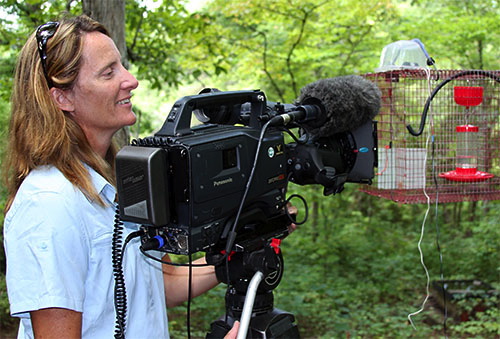
All text & photos © Hilton Pond Center As the remnants of Hurricane Fay departed, the rain abated and our Piedmont weather did finally turn muggy and hot--but not enough to deter a visit by Ann Johnson Prum (above). Ann, a documentarian and videographer, flew down from Connecticut to shoot some footage for a hummingbird program she's working on for the Public Broadcasting System (PBS). The plan is for Ann to meet up with us during one of our expeditions next winter in Costa Rica so she can include an account of our unique research on Ruby-throated Hummingbirds on their tropical wintering grounds. We'll let folks know when the program airs--probably sometime in late 2009. All in all it was a big week at Hilton Pond. Ernesto Carman finally got to see where we spend the rest of the year when we're not studying hummingbirds in his home country; several alumni from our Neotropical trips assembled for our third Costa Rica mini-reunion; we had three new sightings for Hilton Pond Center--Solitary Sandpiper, the flower of Cranefly Orchid, an Owlfly (and the Owlfly's eye); and Ann Prum came to visit with her videocamera for PBS. Most important, however, Hurricane Fay left behind 10.6" of rain and--despite recent real and growing fears--Hilton Pond and its inhabitants were saved once again from turning into dust. Wonder what NEXT week--or the next hurricane--will bring?
All text & photos © Hilton Pond Center
Comments or questions about this week's installment?
Thanks to the following fine folks for recent gifts in support of Hilton Pond Center for Piedmont Natural History and/or Operation RubyThroat: The Hummingbird Project. Your tax-deductible contributions allow us to continue writing, photographing, and sharing "This Week at Hilton Pond." (Please see Support if you'd like to make a gift of your own.)
"This Week at Hilton Pond" is written & photographed You may wish to consult our Index of all nature topics covered since February 2000. You can also use our on-line Hilton Pond Search Engine at the bottom of this page. For a free, non-fattening, on-line subscription to |
|
Make direct donations on-line via
Network for Good: |
|
|
Use your PayPal account
to make direct donations: |
|
|
If you like to shop on-line, you please become a member of iGive, through which more than 700 on-line stores from Barnes & Noble to Lands' End will donate a percentage of your purchase price in support of Hilton Pond Center and Operation RubyThroat. For every new member who signs up and makes an on-line purchase iGive will donate an ADDITIONAL $5 to the Center. Please sign up by going to the iGive Web site; more than 150 members have signed up to help. It's a painless, important way for YOU to support our work in conservation, education, and research. |
|
| The highly coveted Operation RubyThroat T-shirt (four-color silk-screened) is made of top-quality 100% white cotton. It highlights the Operation RubyThroat logo on the front and the project's Web address (www.rubythroat.org) across the back.
Now you can wear this unique shirt AND help support Operation RubyThroat: The Hummingbird Project and Hilton Pond Center. Be sure to let us know your mailing address and adult shirt size: Small (suitable for children), Medium, Large, X-Large, or XX-Large. These quality shirts don't shrink! Price ($21.50) includes U.S. shipping. A major gift of $1,000 gets you two Special Edition T-shirts with "Major Donor" on the sleeve. |
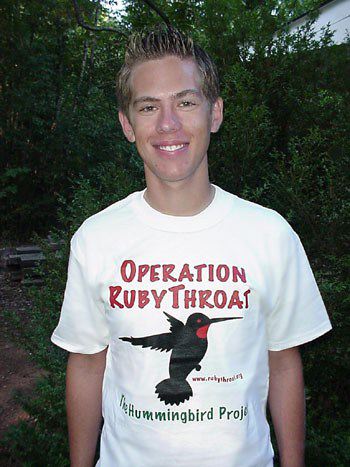
Need a Special Gift for a Want to make a If so, why not use our new handy-dandy on-line Google Checkout below to place your secure credit card order or become a Major Donor today? |
|
|
|
|
SPECIES BANDED THIS WEEK: * = New species for 2008 WEEKLY BANDING TOTAL 9 species 77 individuals YEARLY BANDING TOTAL (2008) 49 species 1,334 individuals 131 Ruby-throated Hummingbirds 27-YEAR BANDING GRAND TOTAL (since 28 June 1982) 124 species 51,501 individuals NOTABLE RECAPTURES THIS WEEK (with original banding date, sex, and current age) 2008 Ruby-throated Hummingbird returns from past years--38 Chipping Sparrow (1) American Goldfinch (3) Northern Cardinal (1) Eastern Towhee (1)
|
OTHER NATURE NOTES OF INTEREST --Although 10.6" of rain from drought-busting Hurricane Fay was welcome, we could still use a bit more--which happened when a sudden thunderstorm hit Hilton Pond Center on the evening of 31 August. In the end the rain gauge "only" read 0.1", but every little bit helps. --When we wrote about the drought two weeks ago we mentioned the Center's hummingbird feeders were being plagued by Yellowjackets. We speculated they, too, were suffering from lack of water--likely because flowers were scarce. We also predicted they would abandon the feeders when rains came. Sure enough, within three days of the end of the deluge described above, the pesky little insects essentially disappeared from our feeders. --26 Ruby-throated Hummingbirds banded during the latest ten-day period brought our 2008 total to 131; that's 112% of the 24-year average of 119 RTHU we've banded by 31 Aug. We're hoping for a very busy first half of September before migration begins to wind down. --Ernesto Carman Jr., who grew up on an organic, shade-grown coffee farm in Costa Rica, is pretty much an expert on how good coffee SHOULD be prepared. Upon his arrival at Hilton Pond we had to take him almost immediately to the local Wal-Mart to purchase a French press--apparently the only true way to brew ground coffee at home. Ernesto insists one should never use a coffee maker that sends coffee nectar through a paper filter; the latter absorbs most of the aromatic oils that give coffee its real flavor. --If you're interested in the Carman family farm in Costa Rica, please visit our photo essay on Shade-grown Coffee: Doing It The "Right Way" (1-7 Feb 2007). There's a link from the Center's page to the Web site for Finca Cristina, from which you can order what is generally considered one of the finest coffees available anywhere. All text & photos © Hilton Pond Center
|
|
|
|
(Back to Preceding Week; on to Next Week) Up to Top of Page Back to This Week at Hilton Pond Center Current Weather Conditions at Hilton Pond Center |
 You can also post questions for The Piedmont Naturalist |
Join the |
Search Engine for |
|
|
women's apparel

 and it was he who had discovered a treasure trove of Ruby-throated Hummingbirds wintering in Aloe Vera fields north of Liberia. By serendipity, Ernesto had described this ruby-throat concentration to a museum curator in San Jose, who in turn mentioned it to Paulo Valerio (Holbrook Travel's in-country coordinator), who then passed the info to Holbrook trip consultant Debbie Sturdivant, who in turn told us while we were putting together our first Holbrook-organized hummingbird banding expedition to Costa Rica. That's why we settled on Guanacaste as our field site that first year and why we've taken six groups to the aloe plantation since then--always with Ernesto as our guide.
and it was he who had discovered a treasure trove of Ruby-throated Hummingbirds wintering in Aloe Vera fields north of Liberia. By serendipity, Ernesto had described this ruby-throat concentration to a museum curator in San Jose, who in turn mentioned it to Paulo Valerio (Holbrook Travel's in-country coordinator), who then passed the info to Holbrook trip consultant Debbie Sturdivant, who in turn told us while we were putting together our first Holbrook-organized hummingbird banding expedition to Costa Rica. That's why we settled on Guanacaste as our field site that first year and why we've taken six groups to the aloe plantation since then--always with Ernesto as our guide. Born in Costa Rica to American parents, Ernesto is thoroughly bilingual--an important plus when we arrive in Costa Rica with minimal skill in speaking or understanding Spanish. This tico is a sponge when it comes to natural history, and he retains an amazingly high percentage of what he sees, hears, and reads about.
Born in Costa Rica to American parents, Ernesto is thoroughly bilingual--an important plus when we arrive in Costa Rica with minimal skill in speaking or understanding Spanish. This tico is a sponge when it comes to natural history, and he retains an amazingly high percentage of what he sees, hears, and reads about.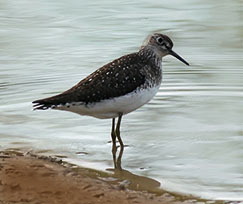 Ernesto seldom has time off, so we were delighted when he was able to visit us at Hilton Pond Center for several days after attending his brother's wedding in St. Louis.
Ernesto seldom has time off, so we were delighted when he was able to visit us at Hilton Pond Center for several days after attending his brother's wedding in St. Louis. He also was astounded and dismayed at the condition of Hilton Pond, suffering from severe drought and in danger of drying up completely in the not-too-distant future. As we walked out on the pier and scanned the wide banks exposed by receding water levels, we saw a long-legged brown bird probing the mud with its slender bill. Initially we thought "Spotted Sandpiper," a species seen several times in past years at the Center. But when the bird turned and gave us a full frontal view, we could see its breast was heavily mottled rather than spotted (above left): Solitary Sandpiper! Amazingly, Ernesto had been in York SC for less than an hour and we already had a new "yard bird"--Species #169 for Hilton Pond.
He also was astounded and dismayed at the condition of Hilton Pond, suffering from severe drought and in danger of drying up completely in the not-too-distant future. As we walked out on the pier and scanned the wide banks exposed by receding water levels, we saw a long-legged brown bird probing the mud with its slender bill. Initially we thought "Spotted Sandpiper," a species seen several times in past years at the Center. But when the bird turned and gave us a full frontal view, we could see its breast was heavily mottled rather than spotted (above left): Solitary Sandpiper! Amazingly, Ernesto had been in York SC for less than an hour and we already had a new "yard bird"--Species #169 for Hilton Pond.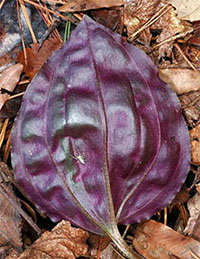 Over the next several days we spent many hours exploring most of the two-and-a-half miles of trails that meander through the Center, identifying flora and fauna and talking about vegetational succession. Ernesto actually got his start in natural history studying orchids in Costa Rica, so he was genuinely excited when we pointed out something new sprouting on the forest floor; in dappled sunlight we had spotted several leafless, 12-inch-high stalks (above right) of Tipularia discolor, the Cranefly Orchis. Unlike tropical orchids that are primarily epiphytes growing on trees, North American orchids are terrestrial and are preferably referred to as "orchis." No matter what we called it, Ernesto recognized the inch-long flowers on the stalk as orchid-like.
Over the next several days we spent many hours exploring most of the two-and-a-half miles of trails that meander through the Center, identifying flora and fauna and talking about vegetational succession. Ernesto actually got his start in natural history studying orchids in Costa Rica, so he was genuinely excited when we pointed out something new sprouting on the forest floor; in dappled sunlight we had spotted several leafless, 12-inch-high stalks (above right) of Tipularia discolor, the Cranefly Orchis. Unlike tropical orchids that are primarily epiphytes growing on trees, North American orchids are terrestrial and are preferably referred to as "orchis." No matter what we called it, Ernesto recognized the inch-long flowers on the stalk as orchid-like.  This was Ernesto's first North American orchid AND the first time we had found the actual blossom of Cranefly Orchis at Hilton Pond Center, even though we knew the plant grows here. Our previous encounters were always in winter, when the plant's bicolored leaf--dark green above and deep purple below (see photo above left)--stands out starkly against the drab brown of decaying leaf litter. This chlorophyll-laden Cranefly Orchis leaf photosynthesizes and sends food to the roots all winter--when there is no canopy to cast shade and compete. As spring arrives
This was Ernesto's first North American orchid AND the first time we had found the actual blossom of Cranefly Orchis at Hilton Pond Center, even though we knew the plant grows here. Our previous encounters were always in winter, when the plant's bicolored leaf--dark green above and deep purple below (see photo above left)--stands out starkly against the drab brown of decaying leaf litter. This chlorophyll-laden Cranefly Orchis leaf photosynthesizes and sends food to the roots all winter--when there is no canopy to cast shade and compete. As spring arrives 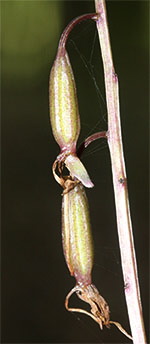 the bicolored foliage disappears, eventually giving rise to a tall flower stalk in late summer. Pollinated by moths, the orchis blossom (above right) resembles the gangly Crane Fly that gives the plant its common name. It's interesting that within a few days after the rains ceased, all the orchis flowers had withered--replaced by seedpods (left) ripening just in time to take quick advantage of suddenly-abundant soil moisture.
the bicolored foliage disappears, eventually giving rise to a tall flower stalk in late summer. Pollinated by moths, the orchis blossom (above right) resembles the gangly Crane Fly that gives the plant its common name. It's interesting that within a few days after the rains ceased, all the orchis flowers had withered--replaced by seedpods (left) ripening just in time to take quick advantage of suddenly-abundant soil moisture.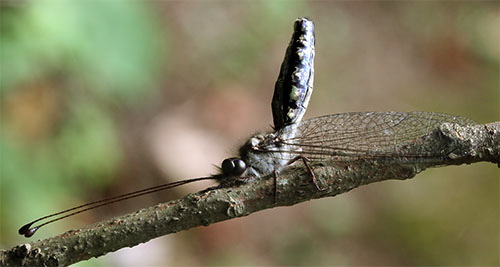
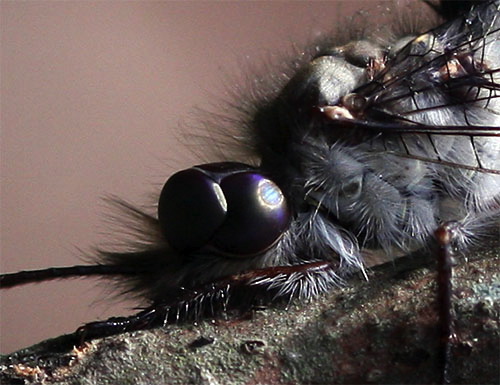
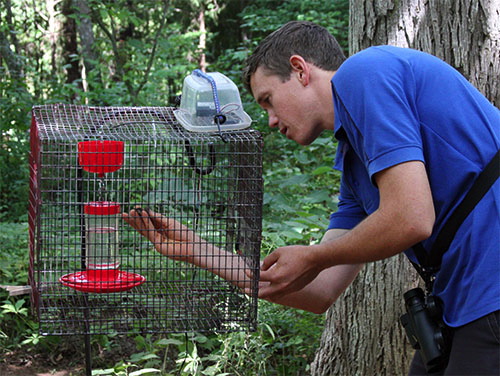
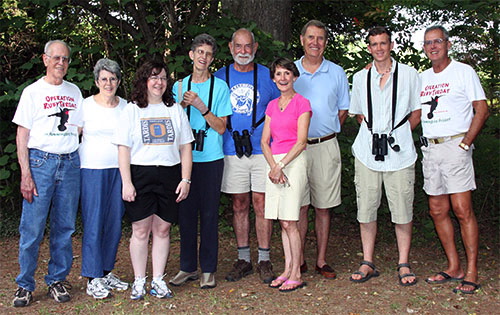
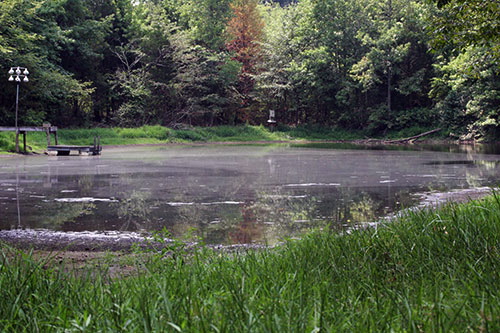



 Please report your
Please report your